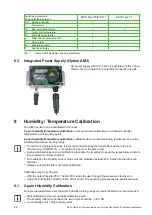
15
EE33 Humidity / Temperature Sensor for High Humidity and Chemical Applications
>75 mm (2.95")
Installation instructions
A
A
B
C
B
B
A
Tighten the nut (A) finger-tight.
Mark the nut (A) at 6 o‘clock position.
Hold the screw connection body (B) tight and tighten the nut
(A) with 1 ¼ turns till 9 o’clock position.
Assembly with high pressure applications and applications
with a high security factor:
Tighten the nut (A) until the probe (C) can no longer be
turned by hand and moved axially in the feedthrough.
Mark the nut (A) at 6 o’clock position.
Hold the screw connection body (B) tight and tighten the nut
(A) with 1 ¼ turns to 9 o’clock position.
Re-mounting:
Slide the measurement probe with clamping ring into the
fitting as far as it goes.
Tighten the nut finger-tight, then tighten by approx. a ¼ turn
using a spanner.
5.5 Remote Sensing Probe Type T10
1/2" ISO or 1/2" NPT
code “cable length”
code “probe length”
adjustable
min. 23 / max. 44/164/364
min. 0.9 / max. 1.7/6.5/14.3
∅
12
(0.47")
∅
13
(0.51")
The sensing probe must be mounted
horizontally or vertically, pointing
downwards. If possible, a drip sheet
should be fitted for each mounting.
Temperature range of sensing probe: -40...180 °C
(-40...356 °F)
Pressure range of sensing probe: 0.01...20 bar
(0.15...300 psi)
General safety instructions for installation
Because the sensing probe can be exposed to very high pressures in the measurement environment,
there is the risk of sudden, unintentional expulsion of the probe during or after improper installation.
Therefore, special precautions should be taken when working on the sensing probe or in its vicinity.
Bending over the sensing probe should be avoided under any circumstances!
During the installation of the sensor probe, make sure that the surface of the sensing probe is not
damaged! Damaging the probe could lead to damaged seals (consequence: leakage and pressure loss)
and to problems during removal (jamming).
Installation of the probe directly in the process






























